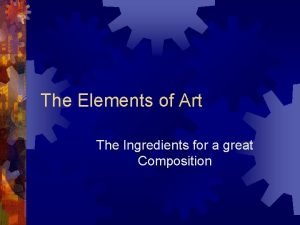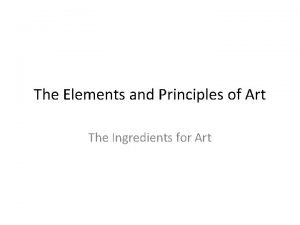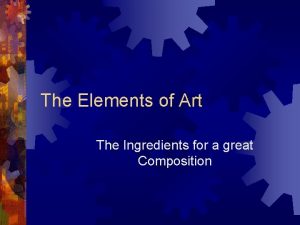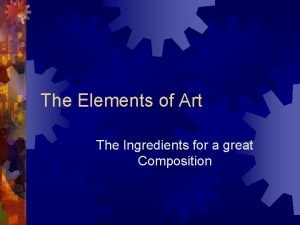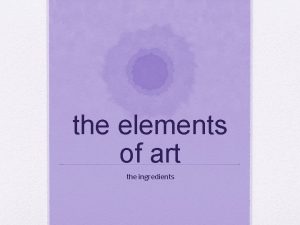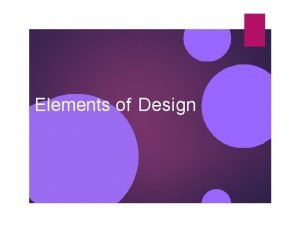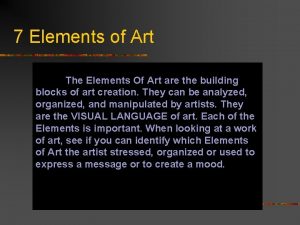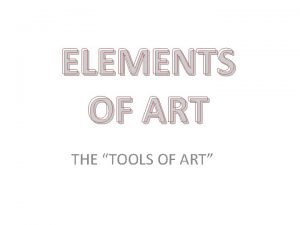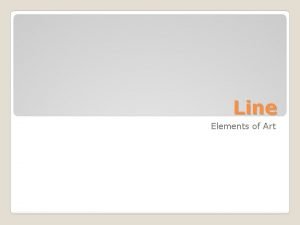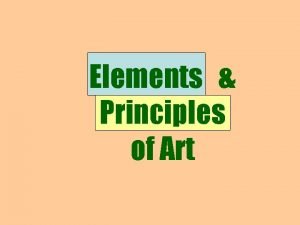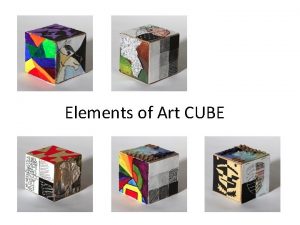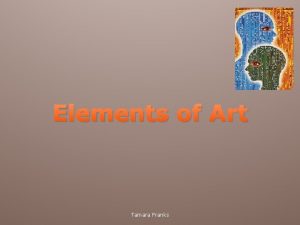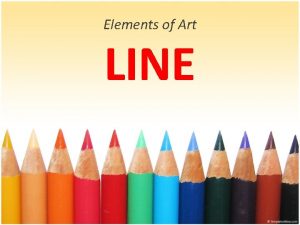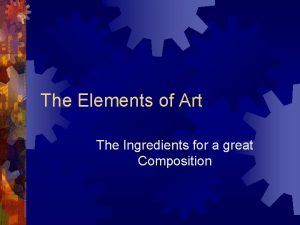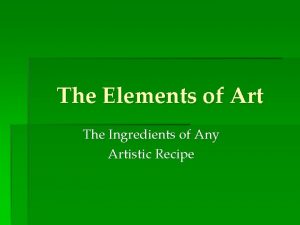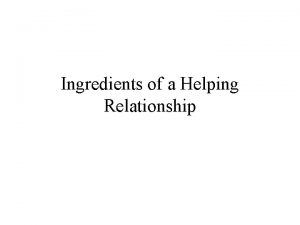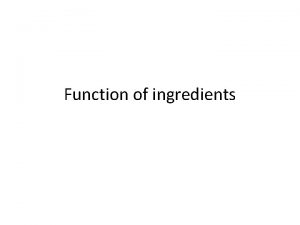The Elements of Art The Ingredients for a



































- Slides: 35

The Elements of Art The Ingredients for a great Composition

What are the elements of art? The Elements of Art are the “tools” that artists use to make art. There are 7 of them: Line Shape Value Texture Form. Space Color

Line A line is a path that a point takes through space. Lines can be thick, thin, dotted or solid. They can make straight movements, zigzags, waves or curls.

Horizontal Lines are generally restful, the sky meets land…

Vertical lines seem to be reaching, so they may seem inspirational like tall majestic trees or church steeples

Diagonal lines tend to be disturbing. They suggest decay or chaos like lightening or falling trees

Implied line • An implied line is a line that is not there. It is a line that we 'complete' in our minds by filling in the blanks, or by 'connecting the dots'. In Matisse's Harmony in Red- he played with the notion of implied line by leaving out the edges of the table.

Shape is created when a line becomes connected and encloses space. It is the outline or outward appearance of something. Shapes are 2 Dimensional (2 -D) which means there are 2 ways they can be measured. You can measure its HEIGHT and its WIDTH. There are two basic types of shape:

Geometric shapes have smooth even edges and are measurable. They are related to mathematical principles. They include the square, the circle, the triangle and the rectangle.

Organic shapes have more complicated edges and are usually found in nature. Leaves, flowers, ameba, etc. They have a natural look and a flowing and curving appearance.

Form A Form is a shape that has become 3 Dimensional (3 -D) Form has HEIGHT, WIDTH and DEPTH--which is the 3 rd dimension. Depth shows the thickness of the object. Forms are NOT flat like shapes are!

Turning Shapes into Forms Any shape becomes a form when you add the third dimension! A triangle becomes a cone or a pyramid A square becomes a cube

Turning Shapes into Forms A rectangle can become a box or a cylinder In order to turn a circle into a sphere, you must shade it. You can’t add another side to it!

Value is the lightness or darkness of a color. Value makes objects appear more real because it imitates natural light. When showing value in a work of art, you will need a LIGHT SOURCE. A light source is the place where the light is coming from, the darkest areas are always on the opposite side of the light.

Value In order to have a successful drawing, you will need to show a full value range, which means that there are very light areas, middle tones, and very dark areas. This is a way of giving a work of art Contrast.

Color • Color is derived from light. It is caused by light waves bouncing back into our eyes. • It identifies objects, creates moods, and affects emotions. • There is no color in the dark! Color itself does not exist.

Color Wheel A long time ago, artists decided that these colors would be more useful to them if they were placed in a wheel fashion. This became known as the color wheel

Color There are 3 primary colors: Red, Yellow and Blue These colors are primary for 2 reasons: 1. They can’t be mixed to be made 2. They make all the other colors on the color wheel

Color When you mix 2 primary colors together, you get a secondary color. For example: Red and Yellow=Orange Red and Blue=Violet Yellow and Blue= Green

Color When you mix a primary and a secondary color together you get an intermediate (or tertiary) color For example: Red and Orange= Red-Orange Yellow and Green=Yellow-Green Blue and Green=Blue-Green Red and Violet=Red-Violet Yellow and Orange=Yellow-Orange Blue and Violet=Blue-Violet

Color Schemes Color is divided into groups based on the way they are placed on the color wheel: 3 -4 colors “next-door-neighbors” to each other creates an analogous color scheme

Color schemes 2 colors that are directly opposite each other (going across the center) creates a complimentary color scheme

Color Schemes A Triadic color scheme uses 3 colors that are equally spaced apart on the color wheel

Color Schemes When you use only one color plus its tints and shades, you are using a monochromatic color scheme A tint is a color plus white A shade is a color plus black

Color Temperatures Warm colors are those that have Reds, Yellows and Oranges. Warm colors seem to advance (or come forward) in an artwork. Cool colors are those that have Blues, Greens and Violets. Cool colors seem to recede (or go back into) an artwork.

Texture is the way the surface of an object actually feels. In the artistic world, we refer to two types of texture---tactile and implied

Tactile (or Real) Texture is the way the surface of an object actually feels. Examples would be sandpaper, cotton balls, tree bark, puppy fur, etc.

Implied Texture is the way the surface of an object looks like it feels. This is the type of texture that artists use when they draw and paint. Textures may look rough, fuzzy, gritty, or scruffy, but can’t actually be felt.

Space • Space is the area around, between, above, below, or within objects. • It is the area provided for a particular purpose. It consists of the foreground, middle ground and background.

Space is basically divided into 3 parts: Foreground, Middle Ground and Background Generally, the background area is considered to be the upper 1/3 of the picture plane. The middle ground area is considered to be the middle 1/3 of the picture plane. The foreground area is considered to be the lower 1/3 of the picture plane.

Space can be shallow or deep depending on what the artist wants to use. Shallow space is used when the artist has objects very close to the viewer.

Space Deep Space may show objects up close but objects are shown far away too.

Space Positive space is the actual object(s) within the artwork Negative Space is the area in and around the objects. It is the “background” and it contributes to the work of art---you can’t have positive space without negative space

Space Perspective is also a way of showing space in a work of art. Perspective is when the artist uses a vanishing point on the horizon and then creates a sense of deep space by showing objects getting progressively smaller as they get closer to the vanishing point.

The Elements of Art in Review The Elements of Art are the “tools” that artists use to make art. They are the basic “foundation” of a good composition Line Shape Value Texture Form. Space Color
 The ingredients of art
The ingredients of art The ingredients of art
The ingredients of art An element that can add interest and reality to artwork
An element that can add interest and reality to artwork Created when a line becomes connected and encloses space
Created when a line becomes connected and encloses space Fspos
Fspos Typiska novell drag
Typiska novell drag Nationell inriktning för artificiell intelligens
Nationell inriktning för artificiell intelligens Returpilarna
Returpilarna Varför kallas perioden 1918-1939 för mellankrigstiden
Varför kallas perioden 1918-1939 för mellankrigstiden En lathund för arbete med kontinuitetshantering
En lathund för arbete med kontinuitetshantering Personalliggare bygg undantag
Personalliggare bygg undantag Vilotidsbok
Vilotidsbok Anatomi organ reproduksi
Anatomi organ reproduksi Densitet vatten
Densitet vatten Datorkunskap för nybörjare
Datorkunskap för nybörjare Stig kerman
Stig kerman Tes debattartikel
Tes debattartikel Delegerande ledarskap
Delegerande ledarskap Nyckelkompetenser för livslångt lärande
Nyckelkompetenser för livslångt lärande Påbyggnader för flakfordon
Påbyggnader för flakfordon Tryck formel
Tryck formel Svenskt ramverk för digital samverkan
Svenskt ramverk för digital samverkan Kyssande vind
Kyssande vind Presentera för publik crossboss
Presentera för publik crossboss Jiddisch
Jiddisch Plats för toran ark
Plats för toran ark Klassificeringsstruktur för kommunala verksamheter
Klassificeringsstruktur för kommunala verksamheter Epiteltyper
Epiteltyper Claes martinsson
Claes martinsson Centrum för kunskap och säkerhet
Centrum för kunskap och säkerhet Verifikationsplan
Verifikationsplan Mat för unga idrottare
Mat för unga idrottare Verktyg för automatisering av utbetalningar
Verktyg för automatisering av utbetalningar Rutin för avvikelsehantering
Rutin för avvikelsehantering Smärtskolan kunskap för livet
Smärtskolan kunskap för livet Ministerstyre för och nackdelar
Ministerstyre för och nackdelar
